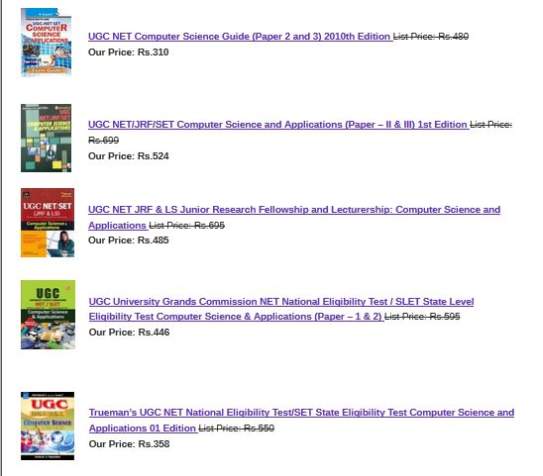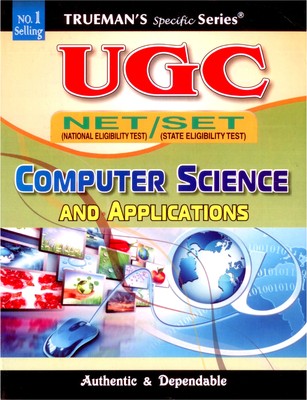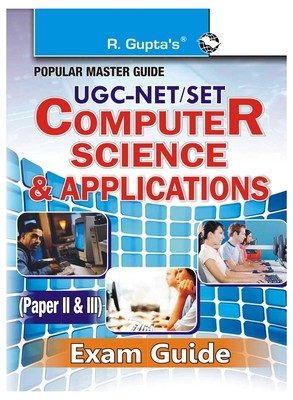List of few books for UGC NET Computer Science exam preparation are given below which you are looking for .
UGC NET Computer Science Guide (Paper 2 and 3) 2010th Edition List Price: Rs.480
UGC NET/JRF/SET Computer Science and Applications (Paper – II & III) 1st Edition List Price: Rs.699
UGC NET JRF & LS Junior Research Fellowship and Lecturership: Computer Science and Applications List Price: Rs.695
UGC University Grands Commission NET National Eligibility Test / SLET State Level Eligibility Test Computer Science & Applications (Paper – 1 & 2) List Price: Rs.595
Trueman’s UGC NET National Eligibility Test/SET State Eligibility Test Computer Science and Applications 01 Edition List Price: Rs.550

For your idea , here I am giving attachment of question paper
SECTION-I
This section contains five (5) questions based on the following paragraph.
Each question should be answered in about thirty (30) words and carries five (5)
marks. (5 5 = 25 Marks)
Read the passage given below and answer the questions that follow based on your
understanding of the passage :
A travel company is in an air-line service. It has two types of aircrafts and has three classes –
Executive, Business and Economy with different fare structure and facilities.
Ticket bookings are computerised and done through agents or directly on phone or in person
at the company’s booking offices. Booking can be preponed, postponed or cancelled. Only
cancellations at any time before 12 hours is charged 20%, after 12 hours but before one hour
charged 40% and after that it is charged 60% but in case of loss of ticket there is no refund.
Customers are offered a choice of veg, non-veg meals in flight. The customers are allowed to
carry one piece of hand baggage of permitted size and weight. Excess weight baggage is
charged separately.
The full ticket amount is to be paid at the time of issue of ticket by cash, cheque, credit card
or debit card is given for 15 days to accredited agents. Draw UML diagrams.
1. Use case diagram
__________________________________________________ _____________________________________________
__________________________________________________ _____________________________________________
__________________________________________________ _____________________________________________
__________________________________________________ _____________________________________________
__________________________________________________ _____________________________________________
__________________________________________________ _________________________
2. Class diagram
__________________________________________________ _____________________________________________
__________________________________________________ _____________________________________________
__________________________________________________ _____________________________________________
__________________________________________________ _____________________________________________
__________________________________________________ _____________________________________________
__________________________________________________ _________________________
3. Sequence diagram
__________________________________________________ _____________________________________________
__________________________________________________ _____________________________________________
__________________________________________________ _____________________________________________
__________________________________________________ _________________________
4. Activity diagram
__________________________________________________ _____________________________________________
__________________________________________________ _____________________________________________
__________________________________________________ _____________________________________________
__________________________________________________ _____________________________________________
5. State chart diagram
__________________________________________________ _____________________________________________
__________________________________________________ _____________________________________________
__________________________________________________ _____________________________________________
__________________________________________________ _____________________________________________
SECTION-II
This section contains fifteen (15) questions, each to be answered in about thirty (30)
words. Each question carries five (5) marks. (15 5 = 75 Marks)
6. Implement the following with NAND and NOR logic
F = (A +
–B
) (
–C
+ D)
__________________________________________________ _____________________________________________
__________________________________________________ _____________________________________________
__________________________________________________ _____________________________________________
__________________________________________________ _____________________________________________
__________________________________________________ _________________________
7. Write assembly language program to execute
A B / C + M
__________________________________________________ _____________________________________________
__________________________________________________ _____________________________________________
__________________________________________________ _____________________________________________
__________________________________________________ _____________________________________________
__________________________________________________ _____________________________________________
8. Given the set of functional dependencies
{A BCD, CD E, E CD, D AH
ABH BD, DH BC}
Find a non-redundant cover. Is this the only non-redundant cover ?
__________________________________________________ _____________________________________________
__________________________________________________ _____________________________________________
__________________________________________________ _____________________________________________
__________________________________________________ _________________________
9. Why are fragmentation and data replication useful in DDBMS ? What are the main
types of fragmentations ? What sort of considerations are used to decide about the
type and extent of Data fragmentation and replications ?
__________________________________________________ _____________________________________________
__________________________________________________ _____________________________________________
__________________________________________________ _____________________________________________
__________________________________________________ _________________________
10. Draw the line between (30, 20) and (40, 28) by determining the pixel locations table
using DDA technique.
__________________________________________________ _____________________________________________
__________________________________________________ _____________________________________________
__________________________________________________ _____________________________________________
__________________________________________________ _________________________
11. Define – Aspect ratio, refresh rate, resolution.
__________________________________________________ _____________________________________________
__________________________________________________ _____________________________________________
__________________________________________________ _____________________________________________
__________________________________________________ _________________________
12. Explain the layer of OSI model, which is responsible for providing node-to-node
communications with reliable service.




